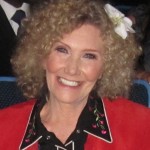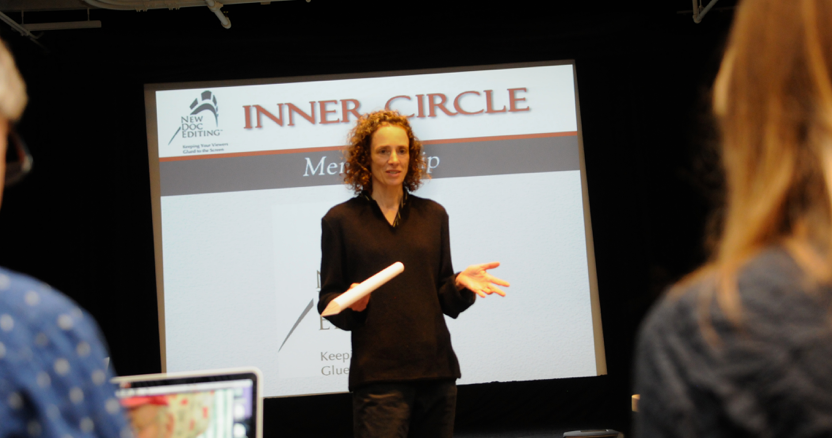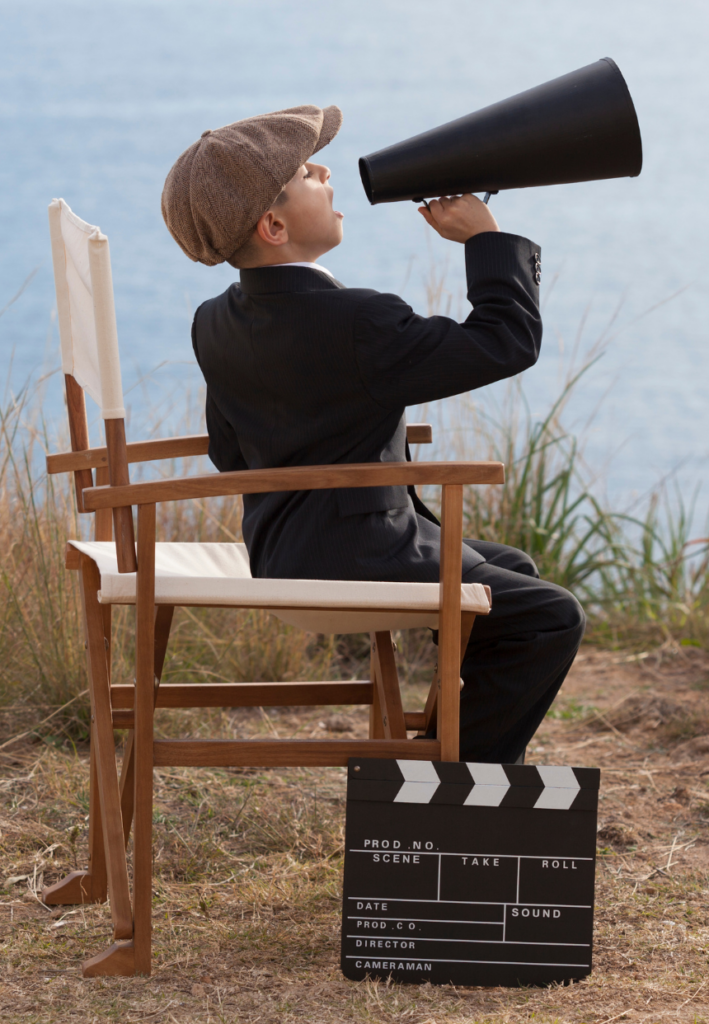The Potential and Rewards of the Three-Act Structure in Documentary Filmmaking
by Carole Dean
In the world of documentary filmmaking, the challenge of applying fictional narrative structures to nonfiction stories can be both daunting and transformative. In a recent class in our Learn Producing Course, documentary editor, educator, and founder of New Doc Editing Karen Everett delved into this intricate process. She revealed her journey and the invaluable insights she gained from working with esteemed editor and story consultant, Deborah Hoffman.
Understanding the Challenge
“I wanted to figure out how can I apply non-fictional structure that’s been around for thousands of years to a nonfiction story,” she said when starting out, “and it was raising all kinds of questions.”
The questions arose around the expectations of conflict escalation in the second act. Real life, she observed, often doesn’t unfold in the neat, incremental manner that fictional narratives demand.
Seeking Expert Help
Recognizing the complexity of her task, Karen acknowledged the need for expert guidance. “I began to suspect that I couldn’t edit this film alone,” she admits. Financial constraints initially prevented her from hiring an editor, but she soon made a pivotal decision. With $5,000 to her name, she sought the expertise of Deborah Hoffman, a renowned editor who had worked on the Oscar-winning documentary “The Times of Harvey Milk.”
Identifying Key Narrative Devices
Deborah Hoffman’s involvement marked a turning point for Karen. “I watched how she intuitively identified the key narrative devices, the inciting incident, the midpoint, and the climax scene,” Karen recounts.
Deborah’s ability to distill complex story elements and eliminate redundancies was crucial. Karen witnessed her pace sequences to ensure that protagonists evolved over time, creating a compelling and coherent narrative.
Making Tough Decisions
One of the most challenging pieces of advice Deborah offered was to reduce the number of characters in the film. “I had eight characters, and she said viewers could follow no more than three, maybe four,” Karen recalls.
Though difficult to hear, this advice was essential. Ultimately, they eliminated four characters whose roles were redundant, focusing on a core cast that included Karen, her girlfriend, an ex-lover who was a close friend, and a lesbian couple in a long-term relationship.
Refining the Narrative
Deborah’s expertise extended to crafting the film’s narration. Despite being a skilled writer, Karen found herself too close to the material to write effective narration for her story. “I was lost in the forest,” she explains. Deborah’s guidance helped translate the film’s ideas for a broader audience, ensuring it resonated beyond the niche community it depicted.
Exploring the Three-Act Structure
Karen’s experience underscores the value of the three-act structure, a tool commonly associated with fictional storytelling. This structure is pivotal in shaping a documentary’s narrative arc.
Act One: The Setup
The first act, or the setup, introduces the protagonist’s desire. In traditional Hollywood terms, this is where “boy meets girl.” For documentaries, this act sets the stage, introducing the key players and the central conflict.
The inciting incident, a crucial event that disrupts the protagonist’s world, propels the narrative forward. As Karen explains, “The inciting incident is a mandatory structural device because it kicks off the real story.”
Act Two: The Conflict
The second act, often the longest, is where the protagonist encounters a series of obstacles. This act is critical for building tension and maintaining audience engagement. “It’s imperative that the editor ratchet up the conflict,” Karen notes. Each barrier the protagonist faces should be more daunting than the last, culminating in an emotional peak greater than that of the first act.
Act Three: The Resolution
In the final act, the protagonist confronts their greatest challenge. “Things are as bad as they can possibly get, and then in act three, they get even worse,” Karen explains. This act is shorter, more suspenseful, and marked by rapid pacing and heightened stakes. The protagonist’s transformation is central to this act, reflecting the core of many character-driven documentaries.
Evolving Through Conflict: Importance of Character Transformation
Karen highlights the significance of character transformation in the three-act structure. “In order for the protagonist to change, they must have a character transformation,” she emphasizes. This transformation often involves challenging the status quo, a departure from traditional narratives where the goal might be to restore equilibrium.
Female Perspectives on Storytelling
Karen also points out the contributions of female screenwriters like Dara Marks, who have enriched the conversation around narrative structure. Marks emphasizes that the protagonist’s journey often involves a deeper, more personal transformation rather than merely overcoming external obstacles.
Crafting a Compelling Documentary
Karen’s documentary, shaped by these principles, serves as a case study in effective storytelling. By focusing on a limited number of characters and emphasizing their personal growth, she created a film that resonated with audiences.
The film’s success, screening at over 50 film festivals and securing distribution on platforms like Amazon and Netflix, attests to the power of a well-structured narrative.
Lessons for Aspiring Filmmakers
For aspiring documentary filmmakers, Karen’s experience offers valuable lessons. Investing in expert guidance, embracing the three-act structure, and focusing on character transformation can elevate a documentary from good to great. By distilling complex real-life events into a coherent and engaging narrative, filmmakers can create stories that captivate and inspire.
Conclusion
Karen Everett’s journey illustrates the transformative power of applying fictional narrative structures to nonfiction stories. Through her collaboration with Deborah Hoffman, Karen learned to harness the three-act structure, refine her narrative, and focus on character transformation. These principles, rooted in traditional storytelling yet adaptable to documentary filmmaking, can guide filmmakers in crafting compelling, emotionally resonant stories.
As Karen’s story demonstrates, the intersection of fiction and nonfiction storytelling holds immense potential. By embracing these techniques, documentary filmmakers can create powerful narratives that not only inform but also deeply move their audiences.
About New Doc Editing – Editing Documentaries that Inspire
They are story-telling experts and can quickly edit your documentary. Or help you edit it through compassionate, insightful story consultations. Their talented editing staff is led by story editor Karen Everett, who taught editing for 18 years at the #1 ranked U.S. documentary program at UC Berkeley.
See IMDb Credits for Karen Everett
Need an editorial roadmap? Or another set of eyes to provide perspective? They excel at bringing to the screen the gems in your footage: strong emotions, cinematic drama, and seminal ideas. Their clients’ films have screened at venues such as SXSW, Sundance, Berlinale, HBO, BBC, and Netflix–as well as local libraries and art theaters.
Click here to contact them.
Carole Dean is president and founder of From the Heart Productions; a 501(c)3 non- profit that offers the Roy W. Dean Film Grants and fiscal sponsorship for independent filmmakers.
profit that offers the Roy W. Dean Film Grants and fiscal sponsorship for independent filmmakers.
She is creator and instructor of Learn Producing: The Ultimate Course for Indie Film Production. Essential classes for indie filmmakers on how to produce their films.
She hosts the weekly podcast, The Art of Film Funding, interviewing those involved in all aspects of indie film production. She is also the author of The Art of Film Funding, 2nd Edition: Alternative Financing Concepts. See IMDB for producing credits


